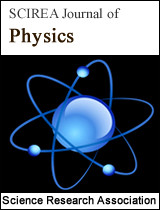The proton charge radius and the proton to electron mass ratio equations
DOI: 220 Downloads 13786 Views
Author(s)
Abstract
Abstract: New expressions in terms of the proton charge radius are derived for the Sommerfeld or fine-structure constant, the proton to electron mass ratio and the elementary particles Wirkungsquanta. Through the derivation of these expressions, it was found that a small correction factor was needed to be applied on the currently accepted proton charge radius numeric value so that the calculated α values were matched with good relative standard uncertainties. Quasi-exact matches to the h-value were used to confirm the numerical value of the used proposed proton charge radius.
Keywords
Fine-structure constant, proton to electron mass ratio, proton radius puzzle
Cite this paper
Emmanuel Saucedo-Flores,
The proton charge radius and the proton to electron mass ratio equations
, SCIREA Journal of Physics.
Volume 5, Issue 5, October 2020 | PP. 108-117.
References
| [ 1 ] | Mohr, P. J.; Taylor, B. N.; Newell, D. B. (2019). "Fine structure constant". CODATA Internationally recommended 2018 values of the fundamental physical constants. National Institute of Standards and Technology. All NIST values shown in manuscript were retrieved on 07 July 2020 |
| [ 2 ] | https://en.wikipedia.org/wiki/Fine-structure_constant last retrieved 10 July 2020 |
| [ 3 ] | Plouffe S. “A search for a mathematical expression for mass ratios using a large database” viXra:1409.0099, (2014). |
| [ 4 ] | Kritov, A. “An Essay on Numerology of the Proton to Electron Mass Ratio” Progress in Physics, volume 11, issue 1, 10–13, (2015). |
| [ 5 ] | Haug, Espen G. “A Speculative Relationship between the Proton Mass, the Proton Radius, and the Fine Structure Constant and between the Fine Structure Constant and the Hagedorn Temperature” (2018). DOI:10.13140/RG.2.2.16650.57286. |
| [ 6 ] | Sayan Patra, J-Ph Karr, L Hilico, M Germann, V I Korobov and J C J Koelemeij “Proton-electron mass ratio from HD+ revisited” Journal of Physics B: Atomic, Molecular and Optical Physics, Volume 51, Number 2 (2017) https://doi.org/10.1088/1361-6455/aa9b92 |
| [ 7 ] | L.-G. Tao. A.-W. Liu, K. Pachucki, J. Komasa, Y. R. Sun and S.-M. Hu “Toward a Determination of the Proton-Electron Mass Ratio from the Lamb-Dop Measurement of HD” Phys. Rev. Lett. 120, 153001 (2018) DOI: https://doi.org/10.1103/PhysRevLett.120.153001 |
| [ 8 ] | Hans-Werner Hammer, Ulf-G Meissner, “The proton radius: from a puzzle to precision” Science Bulletin Volume 65, Issue 4, (2020), Pages 257-258, arXiv:1912.03881v1. DOI: 10.1016/j.scib.2019.12.012 |
| [ 9 ] | Maurizio Bonesini. “The proton radius puzzle”, EPJ Web Conf. 164 07048 (2017) https://doi.org/10.1051/epjconf/201716407048 |
| [ 10 ] | Xiong, W., Gasparian, A., Gao, H. et al. “A small proton charge radius from an electron–proton scattering experiment”. Nature 575, 147–150 (2019). https://doi.org/10.1038/s41586-019-1721-2 |
| [ 11 ] | Pohl, R., Antognini, A., Nez, F. et al. The size of the proton. Nature 466, 213–216 (2010). https://doi.org/10.1038/nature09250 |
| [ 12 ] | Kragh, H. “Magic Number: A Partial History of the Fine-Structure Constant,” Archive for History of Exact Sciences, 57, 5, 395-431 (2003). https://link.springer.com/article/10.1007/s00407-002-0065-7 |

